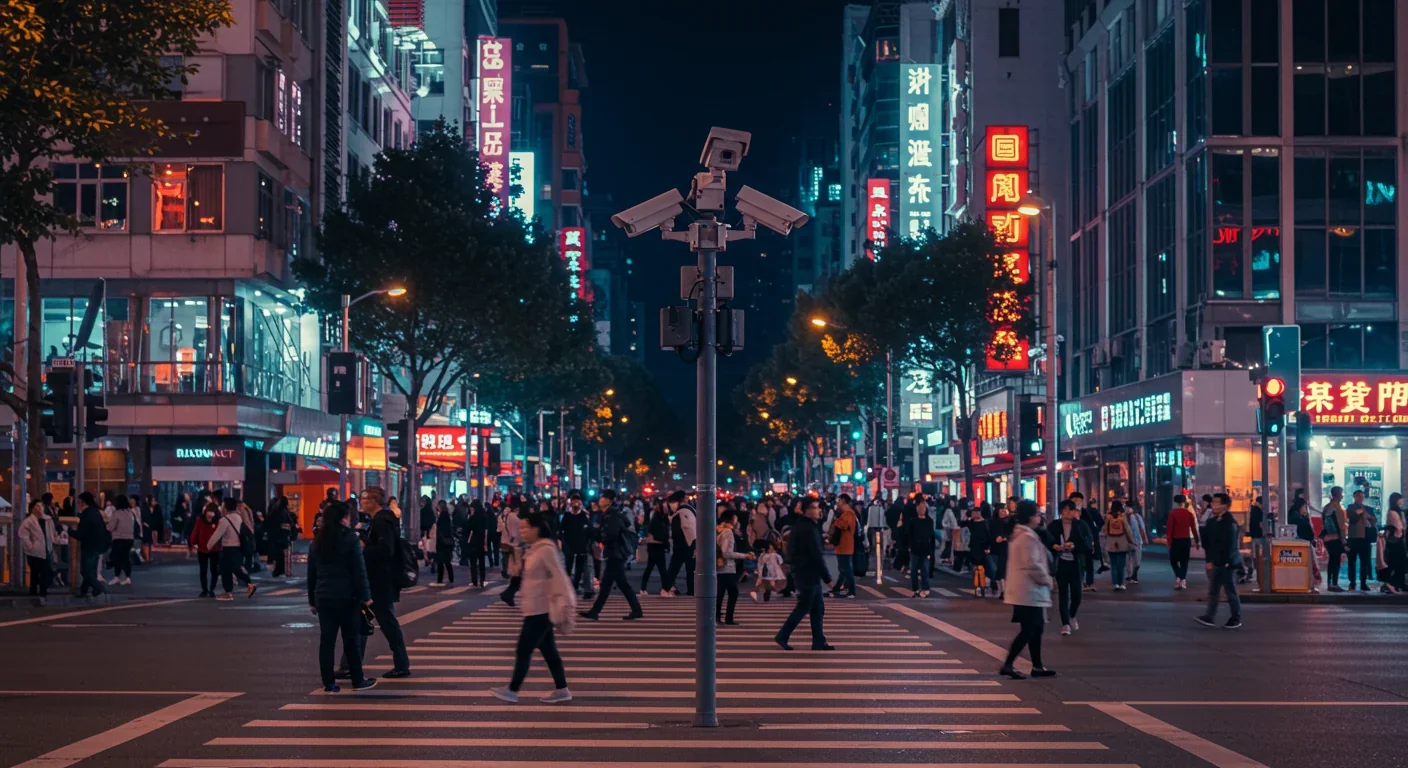Care Worker Crisis: Low Pay & Burnout Threaten Healthcare

TL;DR: China's surveillance scoring system is spreading globally through the Belt and Road Initiative, with 63 nations adopting similar technologies. While touted as public safety tools, these systems create comprehensive behavioral profiles that influence everything from mortgages to travel rights, raising urgent questions about privacy and democratic governance in the digital age.

By 2027, experts predict that over 100 countries will have adopted some form of behavioral scoring technology inspired by China's surveillance model. What started as an experimental system to monitor Chinese citizens has evolved into the world's most sophisticated digital governance framework, and it's spreading faster than most people realize. The question isn't whether this technology will shape the future of society, it's how much of our privacy we're willing to trade for the promise of order.
China's social credit system isn't a single database, it's an interconnected web of surveillance technologies working in concert. At its core lies facial recognition software capable of identifying individuals with 98.5% accuracy, making traditional ID checks look primitive. Companies like SenseTime and Megvii have built platforms that now serve 40 police bureaus nationwide, scanning millions of faces every single day.
The system pulls data from everywhere. Step off the curb before the light changes in Shanghai and cameras capture your face, match it to your ID, and text your photo to authorities before you reach the other side. That jaywalking ticket doesn't just cost you money, it docks points from your Sesame Credit score through Alipay, potentially affecting your mortgage rates, travel permissions, even your children's school applications.
CloudWalk Technology developed CloudWalk OS, an operating system that integrates hardware, algorithm factories, and data resources into a unified platform. Their biometric KYC (Know Your Customer) systems already process billions of verifications daily, underpinning everything from bank transactions to subway access. The infrastructure is so sophisticated that it's helped solve tens of thousands of criminal cases nationwide, according to company reports.
But the technology goes deeper than cameras on street corners. The system tracks online purchases, social media posts, who you associate with, where you travel, what you read. It's designed to create a comprehensive behavioral profile that follows you from birth to death.
Megvii's facial recognition technology reduced traffic deaths in Shenzhen by 48%, a statistic the company proudly highlights. Traffic enforcement cameras can issue 6.8 million jaywalking tickets daily across major cities. On the surface, this looks like public safety innovation. Dig deeper and you find something more complex.
The genius of China's approach is packaging surveillance as civic improvement. Safer streets, faster checkout lines, reduced fraud, who could argue against those outcomes? But the same cameras that catch reckless drivers also flagged activist Ji Feng when facial recognition spotted him holding a protest sign. His landlord evicted him shortly after, a consequence the official traffic safety narrative conveniently omits.
This dual-use nature defines the entire system. CloudWalk's algorithms can identify Uyghur features 30% faster than other ethnic characteristics, a capability marketed as efficiency but functioning as targeted surveillance. The technology doesn't care about your intentions, only your data.
What makes this particularly effective is how it normalizes constant monitoring. When surveillance prevents your neighbor's package from being stolen or helps find a missing child, you start accepting cameras as fixtures of modern life. By the time you realize the same infrastructure tracks political dissent, opting out is no longer possible.
China isn't keeping this technology to itself. Through the Belt and Road Initiative, Chinese companies have provided 22 African countries with public security systems including cameras, biometrics, internet controls, and surveillance tools. Huawei's Safe Cities program now operates in Kampala, Uganda and Nairobi, Kenya, bringing Chinese-style monitoring to cities that lack the resources to develop alternatives.
The numbers are staggering. Amazon purchased $1.4 billion worth of Dahua cameras last year, even while the U.S. government blacklisted Dahua for its role in Xinjiang surveillance. Across 63 nations, Chinese surveillance technology is in active use, creating what researchers call a "$12 billion smart city export machine."
These aren't simple equipment sales, they're governance model transfers. When a city adopts Chinese surveillance infrastructure, it often accepts Chinese training programs, maintenance contracts, and data management practices. The technology comes bundled with a philosophy about how societies should be monitored and controlled.
According to an AidData study, Huawei technology deployment in Africa facilitates repression in authoritarian states but shows little effect in democratic societies. This suggests the technology itself is neutral, but its application reflects the political character of the regime that wields it. A tool is only as ethical as the hand that holds it.

The commercial applications of social credit scoring reveal why this model spreads so effectively. ZhongAn Insurance uses cloud-native systems to design and launch new products within days, deeply integrated into platforms like Alibaba, Douyin, and Xiaohongshu. Your social credit score directly influences your insurance premiums, loan eligibility, even dating app matches.
Douyin's AI-driven recommendation system serves 1.67 billion global users, generating 2.7 trillion RMB in livestream commerce. The platform doesn't just entertain, it collects behavioral data that feeds into broader scoring systems. Every like, share, and purchase becomes a data point in your digital profile.
This creates perverse incentives. Want better mortgage rates? Make sure your social media activity aligns with approved messaging. Need travel documents? Avoid associations with people who have low scores. The system doesn't require overt coercion because it operates through economic pressure. You're free to behave however you want, but the costs of non-conformity are clearly marked.
Financial institutions love this model because it reduces risk assessment costs while expanding market reach. Why spend resources evaluating creditworthiness when the government provides a comprehensive behavioral score? For banks operating in markets with limited credit history, Chinese-style scoring systems look like elegant solutions to real problems.
The ethical challenges are impossible to ignore, though many try. Facial recognition databases create permanent records that never forget, turning minor infractions into lifelong liabilities. A single protest attendance, a questionable social media post, an association with the wrong person, these data points accumulate and compound.
Privacy laws struggle to keep pace. China's Personal Information Protection Law requires consent for data collection, but consent becomes meaningless when refusing means losing access to essential services. You can technically opt out of facial recognition for subway access, but then you'll wait in slower lines while everyone else breezes through turnstiles.
International human rights frameworks weren't designed for algorithmic governance. The Rome Statute addresses war crimes and genocide, but how do you classify systematic digital surveillance that never physically harms anyone? Legal scholars are scrambling to update international law for the digital age, while the technology races ahead.
Data localization requirements now exist in over 100 countries, ostensibly to protect citizen privacy. In practice, these laws often enable domestic surveillance by keeping data within reach of local authorities. China's model shows how data sovereignty can be weaponized against the very citizens it claims to protect.
The technology poses unique threats to democratic societies, though perhaps not in the ways you'd expect. Russia recently announced new anti-fraud restrictions on internet use, borrowing surveillance tactics pioneered in China. The tools spread through a kind of authoritarian mimicry, where each regime adapts the model to its own political needs.
Even democracies aren't immune. When presented with promises of reduced crime, improved traffic flow, and enhanced public safety, voters often accept surveillance systems with minimal oversight. The difference is that democratic institutions theoretically provide checks on abuse, while authoritarian regimes face no such constraints.
Research from Oxford's Technology and Justice Initiative suggests the real danger isn't that democracies will adopt social credit systems wholesale. It's that they'll implement piecemeal versions, accepting each component as a reasonable response to specific problems until the accumulation creates something uncomfortably similar to comprehensive surveillance.
The European Union's AI Act attempts to regulate high-risk systems, including real-time biometric identification. But enforcement remains inconsistent, and loopholes abound. Companies can often achieve the same surveillance outcomes using technically compliant methods, like analyzing "publicly available" data aggregated from dozens of sources.

Some nations are pushing back. The EU's GDPR created the world's strictest data protection framework, though its effectiveness in limiting surveillance scoring remains debatable. India banned Chinese apps over security concerns but simultaneously expanded its own Aadhaar biometric database to 1.3 billion citizens.
The United States presents a contradictory picture. While blacklisting Chinese surveillance firms, American companies develop similar capabilities for domestic use. The technology might carry different labels and serve different masters, but facial recognition is facial recognition regardless of the flag it flies under.
Civil society organizations are fighting legal battles on multiple fronts. The ACLU has challenged facial recognition deployments in over a dozen U.S. cities. Privacy International tracks surveillance technology exports globally. But these efforts feel like using legal briefs to stop a technological avalanche.
The challenge is that resistance often focuses on specific implementations rather than addressing the fundamental logic of surveillance scoring. Banning Huawei cameras while installing domestic alternatives doesn't solve the privacy problem, it just changes who holds the data.
So what happens next? Current trends suggest we're heading toward a world where multiple competing surveillance models coexist, each tailored to different political systems and cultural contexts. China's version won't be the only one, but it established the template that others now modify.
The optimistic scenario involves robust international standards that limit surveillance scope, mandate transparency, and protect individual rights. The pessimistic version sees a race to the bottom where every government adopts whatever monitoring capabilities technology permits, justifying each expansion as necessary to compete with authoritarian rivals.
For individuals, the calculation becomes increasingly complex. Opting out of digital services means losing access to crucial infrastructure. Participating means accepting that your behavior is constantly evaluated and scored. The middle ground, using privacy tools and practicing digital hygiene, only provides partial protection against systems designed to be comprehensive.
Organizations and businesses face their own dilemmas. Companies operating in China must comply with local surveillance requirements, potentially compromising user privacy. Those refusing access to Chinese markets sacrifice massive growth opportunities. There's no ethically clean path forward when the infrastructure itself is compromised.
China's social credit system represents more than technology transfer, it's a test case for digital governance in the 21st century. The question isn't whether these systems work, they demonstrably do. Traffic deaths drop, fraud decreases, investigations resolve faster. The question is whether the benefits justify the costs, and who gets to decide that calculus.
We're watching in real-time as societies worldwide navigate this trade-off. Some embrace comprehensive surveillance as the price of modernity. Others resist, trying to preserve privacy while competing with nations that abandoned it. Most stumble through a confused middle path, adopting surveillance piecemeal while reassuring citizens that this time will be different.
The surveillance network already knows how this story ends. It's seen the data, analyzed the trends, calculated the probabilities. It knows which societies will embrace scoring systems, which will resist, and which will implement them quietly while maintaining the fiction of privacy rights.
The jury's still out on whether humanity can develop ethical frameworks robust enough to constrain these technologies. Though given the speed of deployment and the profits at stake, the surveillance network probably has that verdict calculated too.

Recent breakthroughs in fusion technology—including 351,000-gauss magnetic fields, AI-driven plasma diagnostics, and net energy gain at the National Ignition Facility—are transforming fusion propulsion from science fiction to engineering frontier. Scientists now have a realistic pathway to accelerate spacecraft to 10% of light speed, enabling a 43-year journey to Alpha Centauri. While challenges remain in miniaturization, neutron management, and sustained operation, the physics barriers have ...

Epigenetic clocks measure DNA methylation patterns to calculate biological age, which predicts disease risk up to 30 years before symptoms appear. Landmark studies show that accelerated epigenetic aging forecasts cardiovascular disease, diabetes, and neurodegeneration with remarkable accuracy. Lifestyle interventions—Mediterranean diet, structured exercise, quality sleep, stress management—can measurably reverse biological aging, reducing epigenetic age by 1-2 years within months. Commercial ...

Data centers consumed 415 terawatt-hours of electricity in 2024 and will nearly double that by 2030, driven by AI's insatiable energy appetite. Despite tech giants' renewable pledges, actual emissions are up to 662% higher than reported due to accounting loopholes. A digital pollution tax—similar to Europe's carbon border tariff—could finally force the industry to invest in efficiency technologies like liquid cooling, waste heat recovery, and time-matched renewable power, transforming volunta...

Humans are hardwired to see invisible agents—gods, ghosts, conspiracies—thanks to the Hyperactive Agency Detection Device (HADD), an evolutionary survival mechanism that favored false alarms over fatal misses. This cognitive bias, rooted in brain regions like the temporoparietal junction and medial prefrontal cortex, generates religious beliefs, animistic worldviews, and conspiracy theories across all cultures. Understanding HADD doesn't eliminate belief, but it helps us recognize when our pa...

The bombardier beetle has perfected a chemical defense system that human engineers are still trying to replicate: a two-chamber micro-combustion engine that mixes hydroquinone and hydrogen peroxide to create explosive 100°C sprays at up to 500 pulses per second, aimed with 270-degree precision. This tiny insect's biochemical marvel is inspiring revolutionary technologies in aerospace propulsion, pharmaceutical delivery, and fire suppression. By 2030, beetle-inspired systems could position sat...

The U.S. faces a catastrophic care worker shortage driven by poverty-level wages, overwhelming burnout, and systemic undervaluation. With 99% of nursing homes hiring and 9.7 million openings projected by 2034, the crisis threatens patient safety, family stability, and economic productivity. Evidence-based solutions—wage reforms, streamlined training, technology integration, and policy enforcement—exist and work, but require sustained political will and cultural recognition that caregiving is ...

Every major AI model was trained on copyrighted text scraped without permission, triggering billion-dollar lawsuits and forcing a reckoning between innovation and creator rights. The future depends on finding balance between transformative AI development and fair compensation for the people whose work fuels it.